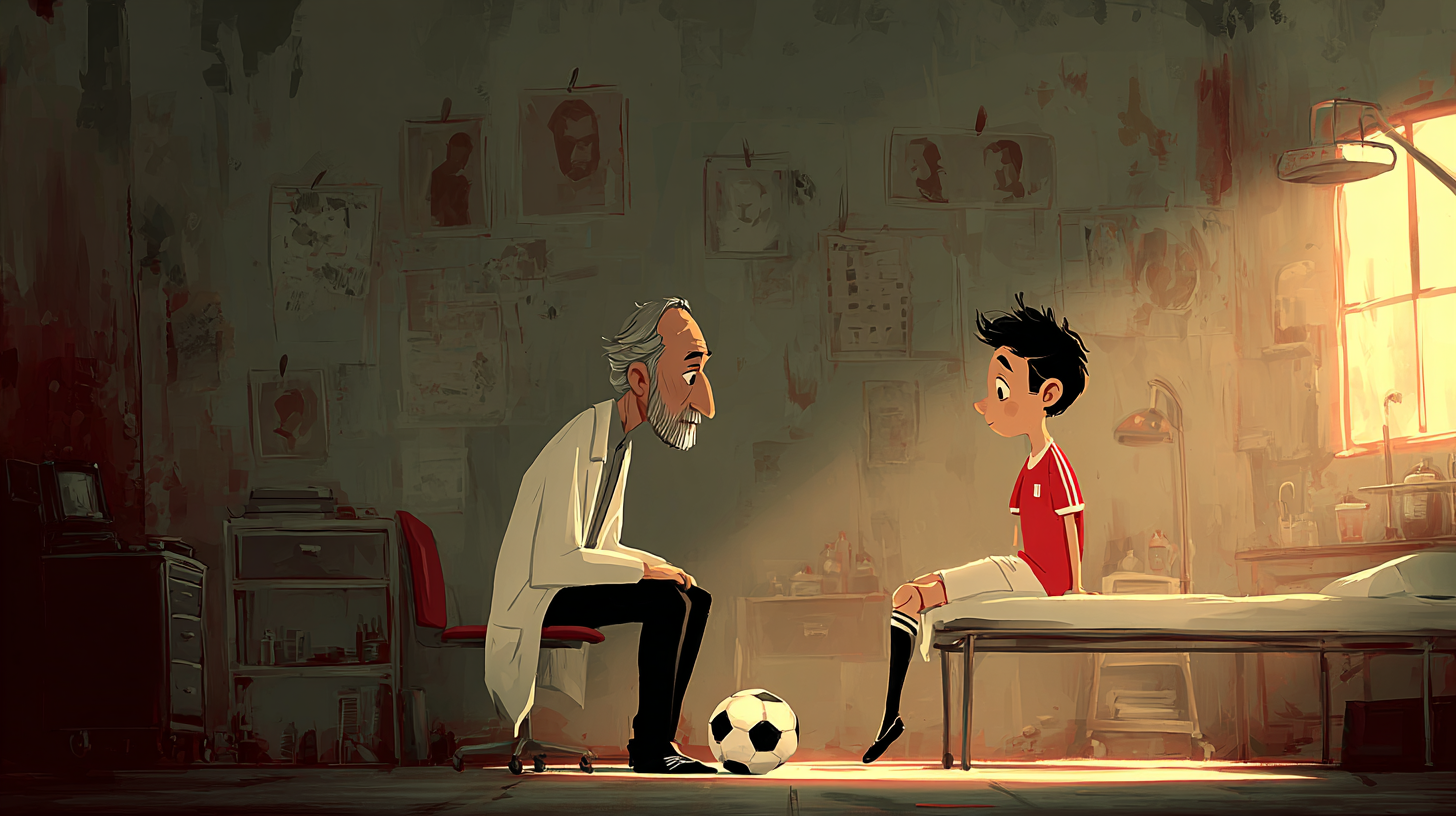Knee means the middle joint of the leg that bends.
knee は「脚の真ん中にある、曲がるところ」
以下は英単語 “knee” に関するストーリー型学習コンテンツです。まずは大枠の意味を理解して最後の文章で確認しましょう。
主な意味(main meaning)
| 品詞 | 意味 | 発音記号 (IPA) | 例文 |
|---|---|---|---|
| 名詞 | ひざ(脚と太ももの間の関節) | /niː/ | She hurt her knee while playing soccer. |
| 動詞 | ひざで押す、ひざを曲げる | /niː/ | The player kneed the ball forward accidentally. |
語源(etymology)
古英語 cnēow に由来し、ドイツ語 Knie と同系。
核となるイメージは「脚の曲がる部分」「支点」。
類義語(synonyms)
| 類義語 | 意味 | 例文 |
|---|---|---|
| joint | 関節 | The doctor checked the joint in her leg. |
| leg | 脚 | He stretched his leg before running. |
| thigh | 太もも | She put the baby on her thigh. |
| ankle | 足首 | He twisted his ankle during the game. |
反義語(antonyms)
| 反義語 | 意味 | 例文 |
|---|---|---|
| elbow | ひじ(腕の関節) | He rested his elbow on the table. |
| shoulder | 肩 | She carried the bag on her shoulder. |
コロケーション(collocations)
| コロケーション | 例文 |
|---|---|
| bend the knee | Knights used to bend the knee to the king. |
| knee injury | The athlete suffered a serious knee injury. |
| knee surgery | She had knee surgery last year. |
| fall on one’s knees | He fell on his knees and prayed. |
| knee pain | He complained about knee pain after running. |
2項表現(binomials)
| 2項表現 | 例文 |
|---|---|
| knees and elbows | The child was dirty on his knees and elbows. |
| head and knees | She bent her head and knees in prayer. |
英語ストーリー(english story)
Story:
Tom was an office worker who loved playing soccer every weekend. One Saturday, he joined a friendly match with his colleagues. During the game, he suddenly fell and felt sharp pain in his knee. He tried to stand up, but the joint felt weak. His friends helped him sit down, and one of them said, “Maybe it’s just a small knee injury, but you should be careful.”
At that moment, Tom remembered last year when his neighbor had to go through knee surgery after a serious accident. He started to worry. He bent his knee slowly, but the pain grew worse. He decided to visit a doctor.
At the hospital, the doctor examined him carefully. “It looks like a minor injury, not a torn ligament. But you should avoid heavy exercise for a while,” the doctor said. Tom felt relieved. The doctor also explained the difference between the knee and other parts of the body, like the elbow and shoulder, so Tom understood exactly where the problem was.
Back at the office, Tom told his colleagues about the accident. One of them laughed and said, “Next time, don’t just use your knee to play soccer. Use your brain, too!” Everyone laughed.
Later, while walking home, Tom saw a little boy fall on the ground. The boy’s knees and elbows were dirty, and he was about to cry. Tom helped him up, remembering his own accident. The boy smiled and said thank you.
That night, Tom thought about the experience. “Our legs, thighs, ankles, and knees are all important,” he said to himself. “We need to take care of them. If they get hurt, we should not ignore the knee pain.” He promised to stretch his thigh and leg carefully before every game from now on.
Tom learned something new: sometimes, we need to bend the knee, not only in front of kings or in prayer, but also in life, when we must accept limits and respect our bodies.
和訳
トムは週末にサッカーをするのが大好きな会社員でした。ある土曜日、同僚たちとの親善試合に参加しました。試合中に突然転んで、鋭い痛みが**knee(ひざ)に走りました。立ち上がろうとしましたが、そのjoint(関節)が弱く感じました。仲間が彼を座らせ、「たぶん小さなknee injury(ひざのけが)**だけど、気をつけたほうがいい」と言いました。
そのときトムは、去年隣人が大きな事故で**knee surgery(ひざの手術)を受けたことを思い出しました。心配になりました。ゆっくりとknee(ひざ)**を曲げましたが、痛みは悪化しました。彼は医者に行くことにしました。
病院で医者は慎重に診察しました。「軽いけがのようですね。靭帯は切れていません。ただし、しばらく激しい運動は避けてください」と言いました。トムは安心しました。医者はさらに**elbow(ひじ)やshoulder(肩)とknee(ひざ)**の違いを説明してくれたので、トムはどこが悪いのか正確に理解できました。
会社に戻ると、同僚たちに事故の話をしました。すると一人が笑って言いました。「今度はサッカーに**knee(ひざ)**だけじゃなく頭も使えよ!」みんなが笑いました。
帰り道、トムは小さな男の子が転ぶのを見ました。男の子の**knees and elbows(ひざとひじ)**は汚れていて、泣きそうでした。トムは彼を助け、自分の事故を思い出しました。男の子は笑顔で「ありがとう」と言いました。
その夜トムは考えました。「leg(脚)、thigh(太もも)、ankle(足首)、そして**knee(ひざ)**は全部大事だ。もし痛めたら、**knee pain(ひざの痛み)を無視してはいけない。」彼はこれから試合の前にthigh(太もも)とleg(脚)**をしっかりストレッチすると誓いました。
そしてこう学びました。「ときには人生でも、**bend the knee(ひざを曲げる)**ことが必要なんだ。王や祈りのときだけでなく、自分の体を大切にするときにも。」
Q&A
Q: “knee” と “joint” はどう違いますか?
A: “knee” は脚の特定の関節(太ももとすねをつなぐ部分)を指します。”joint” は体全体の関節を指す一般的な言葉です。つまり “knee” は “joint” の一種です。
Q: “knee” と “leg” はどう違いますか?
A: “knee” は脚の真ん中にある「関節」の部分だけを指します。”leg” は「脚全体」を意味します。
Q: “knee” と “thigh” はどう違いますか?
A: “knee” は曲がる関節部分で、”thigh” は「太もも」、つまりひざより上の部分を指します。
Q: “knee” と “ankle” はどう違いますか?
A: “knee” は太ももとすねの間にある関節で、”ankle” はすねと足の間にある関節です。両方とも “joint” の一種ですが場所が違います。
Q: “knee injury” と “knee pain” はどう違いますか?
A: “knee injury” は「ひざのけが」という原因そのものを指し、”knee pain” は「ひざの痛み」という症状を指します。
Q: “knee surgery” と “knee injury” はどう違いますか?
A: “knee injury” はけが自体のことを意味し、”knee surgery” はそのけがを治すための「手術」を指します。
Q: “bend the knee” は普通の「ひざを曲げる」とどう違いますか?
A: 日常的な意味では「ひざを曲げる」ですが、歴史的・比喩的には「ひざまずく(王に忠誠を誓う、祈る)」という意味もあります。
Q: “fall on one’s knees” と “bend the knee” の違いは?
A: “fall on one’s knees” は「ひざまずく(倒れるようにして)」で動作の激しさを表します。”bend the knee” は「ひざを曲げてひざまずく」で、儀式的・象徴的な意味合いが強いです。
Q: “knees and elbows” と “head and knees” の違いは?
A: “knees and elbows” は体のよくケガをする部分をセットで表す言い方です。”head and knees” は「頭とひざを同時に曲げる」など、祈りや姿勢を表すときによく使われます。



コメント